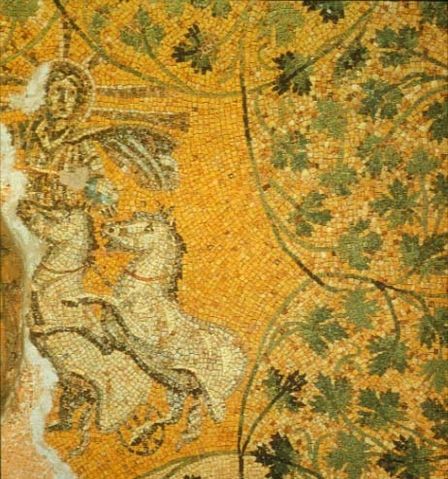Image:ChristAsSol.jpg
From Wikipedia, the free encyclopedia

Size of this preview: 448 × 479 pixels
Full resolution (462 × 494 pixels, file size: 162 KB, MIME type: image/jpeg)
| |
This is a file from the Wikimedia Commons. The description on its description page there is shown below. |
Summary
- Ceiling Mosaic - Christus helios, the mosaic of Sol in Mausoleum M, which is interpreted as Christ-Sol (Christ as the Sun).
Detail of vault mosaic in the Mausoleum of the Julli. From the necropolis under St. Peter's Mid-3rd century Grotte Vaticane, Rome.
Mosaic of the Vatican grottoes under St. Peter's Basilica, on the ceiling of the tomb of the Julii (Pope Julius I). Representation of Christ as the sun-god Helios or Sol Invictus riding in his chariot. Dated to the 3rd century AD.
"Early Christian and pagan beliefs are combined in this third century mosaic of Christ as a sun-god. The triumphant Christ/god, with rays shooting from his head, is pulled aloft by two rearing horses in his chariot. The Dionysian vines in the background become the vines of Christ."
- Title: Christ as Sol Invictus
- Late 3rd century
Source http://faculty.cva.edu/Stout/earlych/earlych.html
"The First Apology" by St. Justin Martyr, an early Christian, quotes Psalm 19:5-6, a verse that was very popular with early Christians. It was associated with the ancient Christian custom of praying toward the East, the direction of Christ's Ascension and second coming, instead of toward Jerusalem as Jews did:
"And hear how it was foretold concerning those who published His doctrine and proclaimed His appearance, the above-mentioned prophet and king [David] speaking thus by the Spirit of prophecy. "....In the sun has He set His tabernacle, and he as a bridegroom going out of his chamber shall rejoice as a giant to run his course."
Christ was also associated with "the Sun of justice with its healing rays", a Messianic image from Malachi 3:20.
From "THE BONES OF ST. PETER : The First Full Account of the Search for the Apostle's Body (Doubleday, 1982) by John Evangelist Walsh"; plate 7 shows a larger black-and-white image; p.26 says that three other mosaics in the tomb on the walls show (a) Jonah falling from a ship and being swallowed by the whale, (b) a fisherman standing on rocks fishing (c) the good shepherd with a sheep across his shoulders. The mosaic on the dome comes half-way down the walls. The rays of light "strongly suggest the form of a cross." The tomb was decorated about 250 with these motifs. The damage to the mosaic on the left is in fact a hole in the centre of the ceiling. The tomb was accessed from the street of pagan Roman tombs, and the access covered by a slab. When this was lifted, the hole in the middle of the dome was accessible. The tomb is described, not as a papal tomb, but as the "tomb of the golden mosaic." Originally it contained a pagan burial of a child and no adornment. Around 250 the family had converted to Christianity, and redecorated it. Three Christian burials were located under the floor. A story from 1574 relates how workmen had opened "a tomb with golden mosaics and two white horses", and found a body on a slab on the floor covered with quicklime; the body was not present when the tomb was located again during the 1941 excavations.
Licensing
The official position taken by the Wikimedia Foundation is that "faithful reproductions of two-dimensional public domain works of art are public domain, and that claims to the contrary represent an assault on the very concept of a public domain". For details, see Commons:When to use the PD-Art tag. العربية | Česky | Deutsch | English | Ελληνικά | Español | فارسی | Français | עברית | Bahasa Indonesia | Italiano | 日本語 | 한국어 | Magyar | Nederlands | Polski | Português | Română | Русский | Slovenščina | Српски / Srpski | Basa Sunda | Türkçe | Українська | 中文(繁體) | 中文(简体) | +/- |
File history
Click on a date/time to view the file as it appeared at that time.
| Date/Time | Thumbnail | Dimensions | User | Comment | |
|---|---|---|---|---|---|
| current | 04:26, 12 January 2006 |  |
462×494 (162 KB) | Leinad-Z | (*Christ as Sol Invictus *late third century *Location: Detail of vault mosaic in the Mausoleum of the Julli, Rome Source http://faculty.cva.edu/Stout/earlych/earlych.html) |
